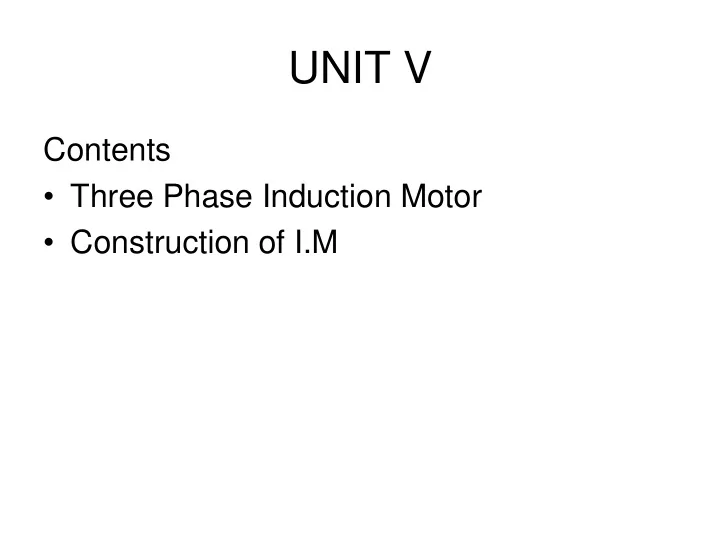

UNIT V Contents • Three Phase Induction Motor • Construction of I.M
Three Phase Induction Motor • Like any Electric Motor, 3-Ph I.M has Stator Rotor • Stator -1. Carries a 3-Ph winding (Stator Winding) 2. Stator is fed from 3 Ph Supply. • Rotor - 1.Carries a Short Circuited winding (Rotor Winding) 2. It derives its voltage & power from the externally energised stator winding through EMI hence name I.M.
Three Phase Induction Motor Advantages i. It has simple and rugged construction. ii. It is relatively cheap iii. It requires little maintenance iv. It has high efficiency and having good power factor v. It has self stating torque Disadvantages i. It a constant speed motor and its speed cannot be changed easily. ii. Its starting torque is low
Construction of I.M
Construction Stator It consists of a hallow Cylindrical core made up of thin laminations of silicon steel to reduce Iron losses. It has a slots and tooth's on its inner periphery to house or place stator windings. i.e in star or delta. The 3-Ph winding is wound for a definite No. of poles as per the requirement of speed. The stator winding having a space displacement of 120 degrees electrical.
Construction Cont.. Rotor Rotor is separated from stator by a small air-gap range from 0.4 mm to 4 mm. Induction Motor animation I_ The Rotating Magnetic(480P).mp4
Construction Cont.. For Animation http://people.ece.umn.edu/users/riaz/animations/ab cvec.html
Construction of I.M
Types of Rotors
Squirrel-Cage Rotor
Applications of Squirrel Cage Induction Motor • Squirrel cage induction motors are commonly used in many industrial applications. • They are particularly suited for applications where the motor must maintain a constant speed, be self-starting, or there is a desire for low maintenance. • These motors are commonly used in: Centrifugal pumps Industrial drives (e.g. to run conveyor belts) Large blowers and fans Machine tools Lathes and other turning equipment
Slip Ring or Wound-Rotor
Production of Rotating Field
AC Machine Stator
Rotating Magnetic Field • Balanced three phase windings, i.e. mechanically displaced 120 degrees form each other, fed by balanced three phase source • A rotating magnetic field with constant magnitude is produced, rotating with a speed N s = 120f e /P Where f e is the supply frequency P is the no. of poles and N s is called the synchronous speed in rpm (revolutions per minute)
Working Principle of an Induction Motor • The induction motor is the single excited motor, i.e., the supply is applied only to the one part, i.e., stator. • When the three phase supply is given to the stator, the rotating magnetic field produced on it. • The conductors of the rotor are stationary. • The stationary conductor cut the rotating magnetic field of the stator, and the EMF induces in the rotor.
Working Principle of an Induction Motor • This EMF is known as the rotor induced EMF, and it is because of the electromagnetic induction • The relative motion between the rotating magnetic field and the rotor conductor induces the current in the rotor conductors. • As the current flows through the conductor, the flux induces on it. • The direction of rotor flux is same as that of the rotor current. Working of Three Phase Induction Motor.mp4
Synchronous Speed • n s = synchronous speed (r/min) – the speed of the rotating magnetic flux • n s = f s /(P /2) (r/s) – where • f s = frequency of the 3- supply • n s = synchronous speed • P = number of poles formed by the stator winding • n s = 120(f s )/P (r/min)
Slip • n s = synchronous speed of the rotating flux • n r = speed of the rotor • slip speed = n = n s -n r • slip = s = (n s -n r ) / n s = per-unit slip • % slip = s x 100% • solving for n r , • n r = n s (1-s)
Effect of slip on rotor frequency • frequency of the voltage induced in the rotor, f r • f r = Pn/120, where – P = the number of stator poles – n = the slip speed (r/min) – f r = rotor frequency (Hz) = P(n s – n r )/120 – f r = P(sn s )/120 = s(Pn s /120) = proportional to s!
“Blocked rotor” condition (n r =0) • s = (n s – n r )/n s = (n s -0)/n s = 1 • f r = s(Pn s /120) = Pn s /120 = same as source • f r = f BR = f stator • In general, f r = sf BR
Recommend
More recommend